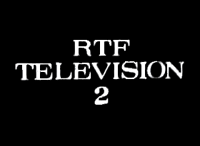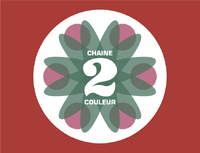France 2 is the flagship channel of France Télévisions, the public TV broadcaster of France. It was known as Antenne 2 until 1992, among other names.
France is the only European country where the flagship public TV channel is not numbered 1. This is because TF1, the former flagship channel and the oldest in France, was privatised in 1987.note
Deuxième Chaîne de la RTF (RTF 2)
1963–1964 (experimental phase)
RTF's second television network, RTF Télévision 2, started experimental broadcasts on December 21, 1963 and had its official start on April 18, 1964. A few months later, RTF was replaced by ORTF.
Deuxième Chaîne de l'ORTF
1964–1967
1967–1972
1972–1975
During the RTF/ORTF years, the channel used a series of 2s to distinguish itself from the first channel. The one seen above was taken from the channel's colour opening animation. La deuxième chaîne was the first French channel to start broadcasting colour in 1967.
Antenne 2
1975–1982
In 1974, it was decided that the ORTF would be broken up into smaller entities, including three separate organizations for each of the TV channels such as TF1 for the first channel, Antenne 2 for the second channel and FR3 for the third channel and its regional networks.
ORTF ceased to be at the end of 1974, and the channels changed their names on January 6. Antenne 2 went in an untraditional direction with a logo created by the painter Georges Mathieu.[1] At the start and end of Antenne 2's broadcast day, there was an animation shown depicting seven flying men in blue coats. At the end of the animation, a large 2 would be revealed and the men would turn around to reveal the letters A, N, T, E, N, N and E written on their coats. The animation was created by Jean-Michel Folon and was accompanied by a sombre melody called played by oboe and orchestra. The melody was written by Michel Colombier and is called Emmanuel from his album Wings. The logo used in other parts of Antenne 2's presentation doesn't appear in this animation. The animations was used by Antenne 2 from its founding in January 1975 to September 1983.
1977-1986
1983-1986
1983–1986
During this period, there was essentially two logos, one long logo with the full name, and a shorter with only the letter A and the number 2 in a circle. In September 1983, It still using electronic animation but now the flying blue men were removed. This opening animation would remain for most of the 1980s, even though a new logo was adopted in 1986.
1986–1987
In 1986, Antenne 2 introduced a new logo, consisting of a written A and a solid 2.
1987-1988
New graphics came in 1987.
1988–1990
1990–1992
Antenne 2's last logo was adopted in 1990. It depicted a 2 on a blue plate.
France 2
1992 (Unused)
1992–2002
On September 7, 1992, the organisations behind the two public television channels, Antenne 2 and FR3, merged to form France Télévision. The names were changed at the same time to France 2 and France 3, and both were given new logos and looks. The new identity for the two channels was created by Gédéon. They started at the numbers of the channels and went for a solution involving splitscreens. France 2's graphics focused on two vertical splitscreens, while France 3's graphics involved three horizontal splitscreens.
France 2 was given a new look about 1995, but this time it was done by the Spanish company Ostra Delta. This package kept the split-screen theme for the break bumpers.
Yet another graphics package was introduced about 1997 and created by View.
On January 4, 1999, France 2 launched a completely new look. This time they went back to Gédéon for their graphics. The new break bumpers abandoned the split screen theme and instead featured dancers. They were done by choreographer Philippe Decouflé.
The dancers went away February 14, 2000 in favour of new break bumpers, designed by Gédéon.
2002–2008
On January 7, 2002, France Télévisions introduced a new look across all its three channels. At the same times La Cinquème changed its name to France 5, in line with its two big sisters. The rebrand cost 2,3 million euros and was done by Gédéon. The new break bumpers for France 2 featured humourous illusions. These break bumpers were obviously popular, as France 2 decided to keep and add to them for most of the remaining decade.
2008–2018
On April 7, 2008, France Télévisions introduced a company-wide image refresh, which included an updated logo and the addition of gradients to the logos of each channel. Although some new graphics were introduced and the logo was moved, this didn't change any fundamental elements of France 2's on-screen presentation.
On January 5, 2009, France Télévisions stopped broadcasting advertising after 8 p.m. In place of the break bumpers, they would now show 20 second idents similar to those in the United Kingdom. The idents were based on two scenes shown side by side that were joined at the end. They were produced by an agency called Ultimatum. There will still be ads in the daytime until 2011, and as break bumpers, they used shorter versions of the idents.
On June 2, 2017, in reaction to Donald Trump withdrawing the United States from the Paris Agreement, the on-screen logo was temporarily colored green (which is the color of the France 5 channel) as a message for saving the planet.
2018–present
On January 28th 2018, France Télévisions introduced a new look for all of its services for the first time since 2002. This new look was designed by Paris-based agency Movement, who also designed the branding package for Franceinfo.
Footnote
- Another example from within the EBU (but outside Europe) is Kan 11, the flagship TV channel of the Israeli Public Broadcasting Corporation (branded as Kan).

























